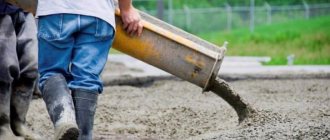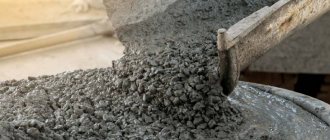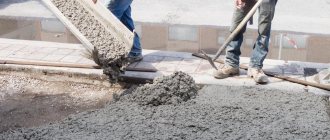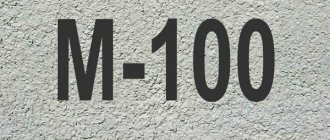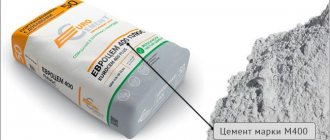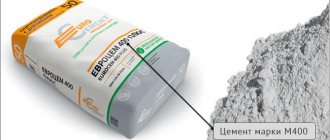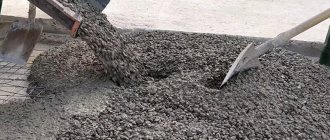Home |Types of concrete |Characteristics of concrete M100
Date: November 20, 2017
Comments: 1
It is impossible to imagine the process of constructing buildings without the use of concrete. Concrete mortars are divided into certain grades and their corresponding classes, depending on the specifics of the work performed. It is not always economically feasible to use concrete solutions with increased strength. In certain situations related to the preparation of the foundation for the foundation, as well as in road construction, M100 concrete is used. It reliably protects steel reinforcement from corrosion and forms a cushion that retains cement laitance in the concrete solution.
Application area
Concrete M100 cannot withstand heavy loads, therefore it has a limited scope. It is imperative to take into account the fact that M100 concrete cannot be exposed to large loads. For structures that will be subject to heavy loads, the use of this solution is unacceptable, otherwise the service life of the constructed building will be short.
What is M100 concrete suitable for?
- preparatory work for foundation installation;
- underlayment devices for road surfaces;
- construction of temporary structures on which work related to reinforced concrete structures will be carried out;
- fixing curb stones;
- filling floors in basements and cellars;
- improvement of local areas;
- interior finishing works in premises.
M100 concrete is laid in a thin layer directly on the soil surface or on a sand cushion that has been compacted in advance. If necessary, the solution can be reinforced with steel reinforcement, this will increase the strength properties. All information about concrete (parameters and characteristics) is reflected in the quality certificate and accompanying technical documentation.
FOR REFERENCE! It is rational to use M100 grade concrete in places where serious performance indicators are not required, and it is planned to save money on construction by reducing the cost of cement mixture.
Pouring concrete is easy, which is why this material is most popular among consumers. After hardening, a reliable structure is obtained that retains high strength for a long time.
Concrete class 100 is B7.5, it is called “skinny” concrete, which should not be used where high strength characteristics are required.
Where is concrete M100 (B7.5) used?
Concrete grade M100 is an inexpensive material that has high ductility and is easy to lay. Therefore, it has become popular in private construction. The material is also used in other areas.
Thus, the M100 brand is in demand in the following areas:
- Construction
- Road construction
- Improvement
- Decor
- Furniture manufacture
- Production of concrete products
Read more about each area in the following parts of the article.
Our own concrete production and laboratory, as well as a large fleet of equipment guarantee high quality products and accurate delivery times
Concrete - production and delivery
Concrete pumps - rent
Read more about us here
7 904 179–31–56
Valentin Yurievich Shvets
Director of BetonStroy
Application of concrete M100 (B7.5) in construction
In construction, the M100 grade is used for:
- Foundations under the foundations
- Filling fence posts
- Foundations under greenhouses and small outbuildings
- Blind areas
- Porches
- Warm floor
- Floors on the ground
The most popular way to use M100 concrete in construction is under foundations. Material 15-20 cm thick is poured directly onto the ground or onto a layer of crushed stone with sand. The layer of concrete itself should be 10-15 cm. It protects the reinforcement from corrosion and plays the role of additional waterproofing and thermal insulation. On this basis, the foundation is stronger and more stable.
M100 concrete can also be used for the foundation itself. But this brand can only be used for very small buildings - greenhouses, booths and sheds. The base underneath does not bear a large load, and the use of low-grade concrete allows for savings.
Fence posts are also poured with M100 concrete, a blind area is made from it, and the porch of the house is covered. Indoors, the material is used to fill the floor. But if possible, it is recommended to use more durable brands for such purposes. After all, the M100 is an inexpensive option. In construction it is used as a material that allows saving money. Before using this brand, you should consider whether it would be better to take a higher class material.
Application of concrete M100 (B7.5) in road works
In road construction, M100 concrete is not in great demand. Its characteristics do not meet the requirements necessary for this type of work. The road surface consists of several layers, the total weight of which reaches tens of tons. To withstand such pressure, the foundations must be very strong. In addition, vibration and pressure from passing vehicles are destructive.
Grade M100 in road construction is used only for a few types of work:
- Creating a base foundation under the roadway
- Repair
- Equipment for curbs and roadsides
The thin base between the soil and the remaining layers of pavement plays the role of waterproofing. It prevents the drift of earth particles into layers of sand and crushed stone, and the ingress of moisture during a sharp rise in groundwater. Concrete is poured either onto a sand-crushed stone bed or simply onto the ground.
Grade M100 can be used for minor repairs of concrete road surfaces. It is plastic, convenient for sealing small recesses and cracks.
This class of concrete can be used to make curbs that do not carry a large load. The material is poured into the foundations under the curbs, if there is a need to install them along the road.
As in the case of conventional construction, in road work M100 concrete is a fallback option. It is chosen when laying roads with medium and low traffic, if you want to save money. To make the road truly reliable, it is better to use concrete of higher classes.
The use of concrete M100 (B7.5) in landscaping
Landscaping is one of the main areas of application of M100 concrete. This type of work does not require particularly strong material, because most objects do not carry a large load. Choosing the M100 brand means saving without losing quality.
The M100 loaf is used for:
- Foundations under sidewalks
- Curb installations
- garden paths
- Yard sites
- Bicycle paths
- Sports grounds
- Skateparks
- Entrances
- Parking lots and parking
As the main type of material, the M100 brand is used when arranging garden paths, sidewalks and laying borders. It can fully withstand the loads that such objects carry. In most cases, concrete serves as the base here. Asphalt, paving slabs, and stone are placed on top of it. Curbs are made both from concrete itself and from other materials - stone, brick, wood.
When arranging courtyards and sports grounds, skateparks, bicycle paths and parking lots, you should consider how they will be used.
Here are some examples:
- If a small courtyard area is used exclusively as a pedestrian zone, there are no public events held there, there are no retail outlets and very few people pass by during the day, M100 concrete is perfect for it.
- Another example is a bike path that runs along a busy street. A couple of hundred bicycles and electric scooters pass through it every day. In this case, you can use M100 concrete for pouring, but you need to understand that such a path will quickly wear out. It is better to give preference to more durable brands - M150-M250.
- Let's say there is a small sports ground in the yard. If several children play on it (play football, basketball, run), and the concrete is lined with a soft rubber coating on top, then in this case the strength that the M100 brand will provide will be quite sufficient.
- Are you planning to install parking for your car in the yard of your own home? It is enough to fill it with M100 concrete. But for public parking it is better to use other brands.
As can be seen from the examples, the M100 brand is suitable only for objects where the load is minimal.
The use of concrete M100 (B7.5) in decoration
Various decorative elements can be made from concrete. They are used both indoors and outdoors. The material for such products should not have high strength. Often it is made only from sand and cement. If crushed stone is added, then the smallest fraction is chosen. Sometimes colored stone is used - pink granite, diorite, brown or yellow limestone.
The M100 brand is perfect for decoration. If you decide to make the elements yourself using a special form, it will not be difficult to mix concrete of this class by hand. After all, the material has good ductility and is easy to work with. But professionals recommend adding plasticizers to it.
Brand M100 is suitable for the following decorative elements:
- Stucco moldings
- Ceiling and wall finishing
- Curly balusters for stairs
- Fireplace decoration
- Items for the home (candlesticks, vases, chandeliers, coasters)
The brand is best used for home decor. Indoor objects will not be susceptible to aggressive environmental factors.
Application of concrete M100 (B7.5) in the furniture industry
Concrete furniture is most often installed in garden plots, parks, and city streets. But recently it has appeared in the home interior. Countertops, bar counters, and fireplaces are made from this material.
The M100 concrete grade is suitable for outdoor furniture, but as an inexpensive option if you want to save money.
From it you can make:
- Benches
- Cabinets
- Pedestals
- Vases and flower tubs
It is best if garden furniture made of M100 concrete is under a canopy and protected from rain and snow. If it is installed in an open space, use stronger concrete M150-M250.
For home furniture, concrete M100 is a very profitable option. It is inexpensive and easy to form into objects of any shape. Most often, solutions for furniture are prepared from sand and cement; very rarely, fine colored crushed stone or screenings are added.
In home interiors, sinks and fireplaces are also made from concrete. The M100 brand is not very suitable for these purposes. The sink is constantly in contact with water, and the fireplace heats and cools. Therefore, the concrete in such products must be more durable.
Application of concrete M100 (B7.5) for the production of reinforced concrete products
Concrete grade M100 is not used for the manufacture of reinforced concrete products.
But it is used as an auxiliary material for:
- Thermal insulation
- Protection of fittings from corrosion
- Sealing gouges and cracks
Concrete mortar is applied in a thin layer over the product, onto the iron elements. The advantage of the brand is its plasticity. It easily fills any unevenness and lies evenly on the surface.
Specifications
Concrete M100 is created according to established standards. The binder is cement, the fillers are sand and crushed stone mixed with water. This is a simple solution, its cost is low. The presented brand of concrete has a certificate of conformity and has the following technical characteristics:
- Density – from 2.37 t/m3 to 2.4 t/m3. Depends on the size of the filler.
- Strength – M100 concrete has low strength and can withstand loads of 98 kg/cm2.
- Frost resistance – F50-F100, these indicators indicate that defects in the form of cracks do not form on the poured surface after 50-100 freezing cycles.
- Mobility – P2-P4. The concrete solution is very elastic and does not cause problems when compacted.
- Waterproof - W2-W The level of waterproofness indicates that the material can create a protective barrier without loss of cement laitance.
- Hardness – Zh2-Zh4. Material with such indicators indicates that after pouring, M100 concrete retains its shape, which simplifies further construction work.
FOR REFERENCE! Water resistance and frost resistance depend on the size of the filler. Expanded clay, gravel, limestone, crushed stone, granite, etc. can be used as filler.
The specific gravity also depends on the type of filler:
- 0.5-1.8 t – specific gravity of the solution using expanded clay and shell rock granules, refers to lightweight concrete;
- 1.8-2.3 t – specific gravity of the solution using crushed stone or coarse gravel, refers to heavy construction mixtures;
- 3t – specific gravity of a particularly heavy solution that has metallic inclusions.
During the design process and calculations, it is necessary to take into account the specific gravity and density of the concrete mixture. As a rule, in construction they use such a parameter as volumetric weight, which is equal to 1.84 tons for M100 concrete.
Compound
To obtain a high-quality solution, it is necessary to follow the correct preparation technology. M100 concrete contains a small amount of cement mixture, which serves as a bonding agent for the aggregate. In addition, it is important to comply with the established proportions. The composition of the mixture depends on its purpose. Since M100 concrete is not suitable for structures subject to high pressure, it also contains less hydraulic binder compared to concrete of a higher grade.
It is advisable to choose proven recipes for preparing the solution and comply with current standards. The concrete mixture consists of the following components:
- cement of various brands, which serves to adhere all components of the solution;
- washed river sand and sand-gravel mixture;
- crushed stone or other fillers, for example, medium-sized fractions based on gravel chips;
- water, which is poured into all the dry ingredients, then everything is thoroughly mixed.
The composition of concrete grade 100 is presented in the table:
| Cement grade (C) | Mass composition: C: sand: crushed stone | Volume composition: C: sand: crushed stone | Amount of concrete from 10 liters of cement, l |
| M400 | 1:4,6:7 | 1:4,1:6,1 | 78 |
| M500 | 1:5,8:8,1 | 1:5,3:7,1 | 90 |
From the above table we can conclude that the ratio of components for preparing a concrete solution of grade 100 depends on the brand of cement. When using M400 cement, less crushed stone or gravel is required than when using M500 grade. And the final volume of mortar with M500 cement is always greater than with M400.
Also, the proportions depend on factors such as:
- Filler fraction;
- Sand fraction;
- Density of crushed stone;
- Requirements for the quality of the mixture.
FOR REFERENCE! If necessary, a variety of special additives can be added to the concrete mixture, which affect certain performance characteristics.
Concrete heavy class 15 m200 – strength gain
Hydration of cement in the concrete mixture occurs gradually and is completed four weeks after class B15 concrete is poured. By this time, the building material acquires operational strength, allowing further construction work to be carried out and the monolith to be subjected to loads.
The intensity of hardening is influenced by the following factors:
- temperature conditions. The optimal temperature for normal hardening is 18–20 degrees Celsius;
- moisture concentration in the air. In dry and hot weather, the surface must be moistened periodically;
- wind. The rate of moisture evaporation increases in windy weather. To maintain moisture in the hardening mass, it is moistened.
Advantages and disadvantages
Advantages of M100 concrete:
- Low cost and availability of materials, which will reduce construction costs.
- Reliability, that is, when exposed to various adverse natural phenomena, the structure will maintain its integrity.
- Durability. Thanks to the existing technical and strength indicators, M100 concrete is capable of not losing its properties for a long time.
- Safety. The components included in the concrete solution are absolutely safe and environmentally friendly; they are not capable of having a detrimental effect on human health.
- Availability of excellent technical indicators.
- Moisture resistance. Concrete does not collapse when exposed to moisture and protects reinforcing bars from corrosion.
- Although the area where this brand of concrete is used is limited, it is still wide. It is used both in the construction of roads and in the construction of houses.
- Frost resistance. The solution can withstand from 50 to 100 cycles of freezing and thawing, so it can be used in any climate zone.
The main advantages of this concrete are its resistance to moisture and interaction with the soil. This feature allows you to carry out work on arranging paths in parks and gardens, installing fence posts, as well as other work where there is contact with the ground.
Flaws:
The main disadvantage of M100 concrete is its low strength after hardening. After preparing the base, steel reinforcement is laid on the surface of the M100 concrete screed. Then they begin to work with concrete of the higher grade. The disadvantages include:
- Possibility of cracks. Because of this, the integrity of the structure is compromised and performance is reduced.
- M100 concrete cannot be used for load-bearing structures due to its low strength.
To increase strength indicators and reduce the likelihood of defects, various bitumen-based emulsions are added to the mixture.
Answers to frequently asked questions
What does concrete strength mean?
Strength is an important quality that depends on the degree of interaction of cement with added water under optimal conditions for preparing the solution. Therefore, strength decreases when preparing the solution in frosty or very hot weather, which leads to destruction of the concrete base.
What does frost resistance mean?
Frost resistance is the number of possible periods of freezing and freezing of the concrete base, which does not lead to damage. This quality is quite important in the construction of road surfaces, which are influenced by a large number of adverse factors and weather conditions.
What does moisture resistance mean?
Water resistance is the quality of concrete to withstand moisture without breaking down. Based on their resistance to water, concrete is divided into grades from W2 (lowest) to W12 (highest).
Price
Determining the cost of the material is influenced by:
- price per brand of cement and fillers;
- electricity costs (if the solution is mixed using a concrete mixer);
- period of work;
- delivery costs to the construction site;
- construction region.
For example, the price of 1 m3 of M100 concrete in Moscow is 2600-3300 rubles. Most often, the concrete mixture is sold along with transportation. Transport costs are 400-700 rubles per 1m3. Since unloading the material takes time, and the machine is waiting for complete unloading at this time, you will have to pay for the wait - approximately 1000-1500 per hour.
Mixing proportions
Mixing is done manually or using a concrete mixer. The use of a concrete mixer is suitable if you need to mix a large amount of solution, for example, when applying concrete mixture to a sand bed.
For manual mixing you need: a metal container, a shovel, a bucket and a hoe. The dry ingredients are poured into a container and mixed with a hoe. After thorough mixing, water is added. You should not pour all the water into the mixture at once; first you need to add 7-8 liters and mix until the dry lumps disappear.
The proportions depend directly on the brand of cement used. If concrete is mixed using M400 cement, then the following is required:
- 250 kg of cement;
- 0.7-0.8 m3 crushed stone;
- 0.6 m3 of sifted sand;
- 0.15-0.2 m3 of water (it is necessary to achieve the desired consistency of the mixture).
The volume of water changes during the mixing process in accordance with the required density of the concrete mixture. If the solution turns out to be too thick, then add water in small portions, then mix thoroughly to the required state. Sometimes the method of calculating components by weight is used, then the proportions are calculated in kilograms.
If you mix using M500 cement, you need:
- 200 kg of cement (1 part);
- 800 kg of sand (4 parts);
- 1200 kg of crushed stone (6 parts);
- about 190 liters of water (approximately 1 part).
The final proportions may vary depending on the density of M100 concrete, the purpose of the solution, the quality and dimensions of the filler and other parameters. Most builders are guided by the ratios: M400 - 1 part cement, 7 filler, 4.6 sand: M500 - 1 part cement, 8.1 filler, 5.8 sand. The volume of water is determined during mixing.
Preparing the mixture for the pillow
When using concrete grade 100, the technology for pouring the concrete mixture onto the pad is simple. The operating algorithm is as follows:
- First, the platform and the bottom of the pit are leveled.
- Next, a sand layer is distributed, then a layer of crushed stone, which is 10-15 cm.
- After laying, the materials are compacted or filled with large amounts of water.
- The concrete is laid evenly, the layer thickness is 10-15 cm. Then you need to wait until it hardens completely.

